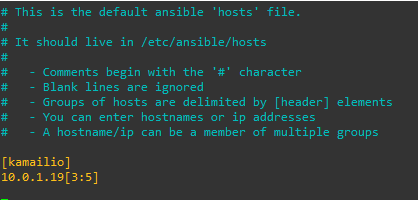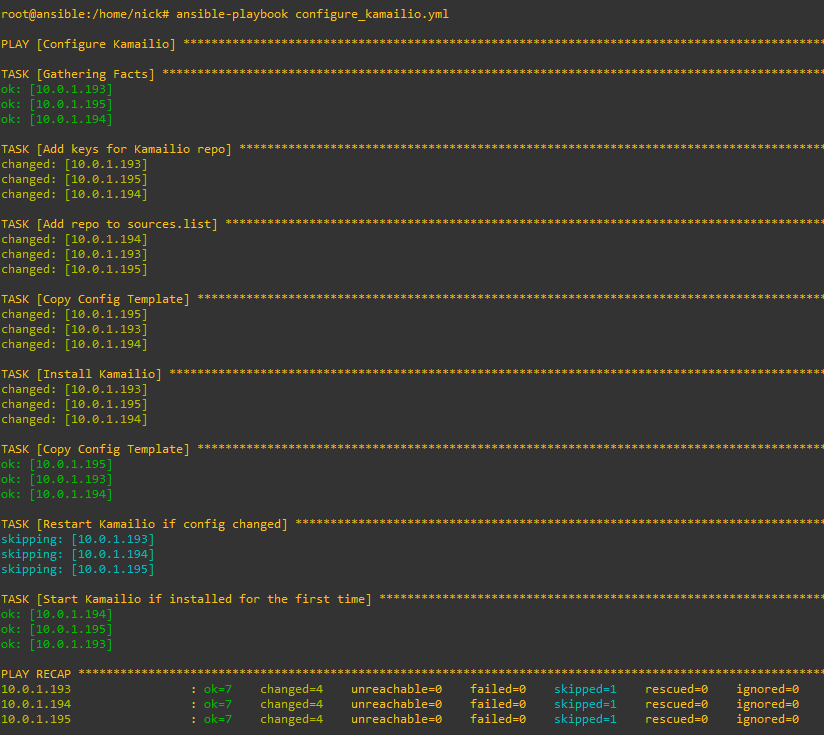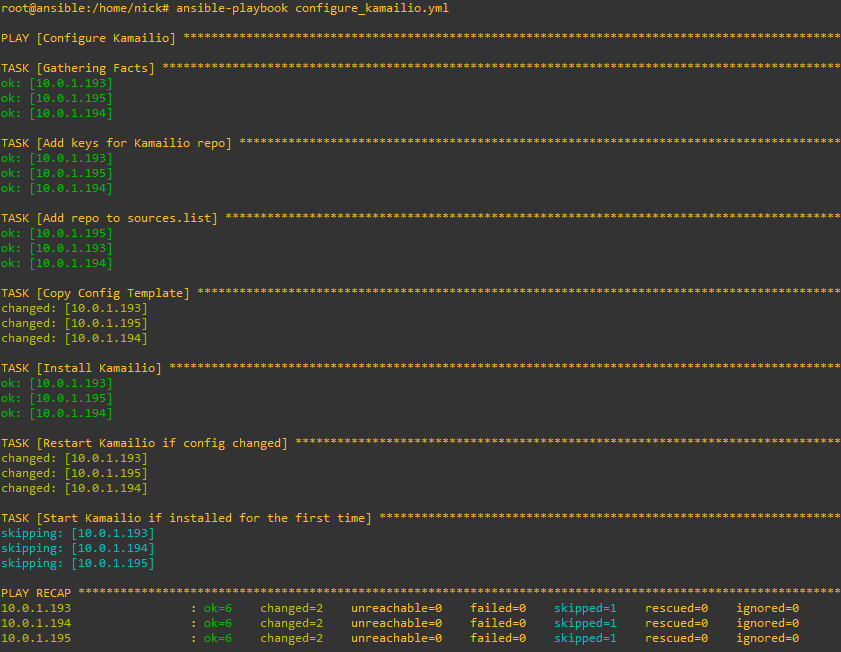There’s always lots of talk of Network Function Virtualization (NFV) in the Telco space, but replacing custom hardware with computing resources is only going to get you so far, if every machine has to be configured manually.
Ansible is a topic I’ve written a little bit about in terms of network automation / orchestration.
I wanted to test limits of Open5gs EPC, which led me to creating a lot of Packet Gateways, so I thought I’d share a little Ansible Playbook I wrote for deploying P-GWs.
It dynamically sets the binding address and DHCP servers, and points to each PCRF in the defined pool.
You can obviously build upon this too, creating another playbook to deploy PCRFs, MMEs and S-GWs will allow you to reference the hosts in each group to populate the references.
The Playbook
---
- name: Install & configure Open5GS EPC (P-GW)
hosts: epc
become: yes
become_method: sudo
vars:
dns_servers: ['8.8.8.8','1.1.1.1']
diameter_realm: 'nickvsnetworking.com'
pcrf_hosts: ['pcrf1.nickvsnetworking.com', 'pcrf2.nickvsnetworking.com']
tasks:
- name: Set Hostname to {{inventory_hostname}}
hostname:
name: "{{inventory_hostname}}"
register: rebootrequired
- name: Updating hotnamectl
command: "hostnamectl set-hostname {{inventory_hostname}}"
become: True
become: True
when: rebootrequired.changed
- name: Reboot VM due to Hostname Change
reboot:
reboot_timeout: 180
when: rebootrequired.changed
- name: Add Software common
apt:
name: software-properties-common
- name: Add Repository
apt_repository:
repo: ppa:open5gs/latest
- name: Install Open5gs P-GW
apt:
update_cache: true
name: open5gs-pgw
- name: Fill in GTP Addresses in Config
template:
src: pgw.yaml.j2
dest: /etc/open5gs/pgw.yaml
backup: true
register: config_changed
- name: Fill in P-GW Diameter Config
template:
src: pgw.conf.j2
dest: /etc/freeDiameter/pgw.conf
backup: true
register: config_changed
- name: Restart P-GW Service if Config Changed
service:
name: open5gs-pgwd
state: restarted
when: config_changed.changed
Jinja2 Template
P-GW Config (pgw.yaml.jn2)
logger:
file: /var/log/open5gs/pgw.log
parameter:
pgw:
freeDiameter: /etc/freeDiameter/pgw.conf
gtpc:
- addr: {{hostvars[inventory_hostname]['ansible_default_ipv4']['address']}}
gtpu:
- addr: {{hostvars[inventory_hostname]['ansible_default_ipv4']['address']}}
ue_pool:
- addr: 45.45.0.1/16
- addr: cafe::1/64
dns:
{% for dns in dns_servers %}
- {{ dns }}
{% endfor %}
Diameter Config (pgw.conf.j2)
# This is a sample configuration file for freeDiameter daemon.
# Most of the options can be omitted, as they default to reasonable values.
# Only TLS-related options must be configured properly in usual setups.
# It is possible to use "include" keyword to import additional files
# e.g.: include "/etc/freeDiameter.d/*.conf"
# This is exactly equivalent as copy & paste the content of the included file(s)
# where the "include" keyword is found.
##############################################################
## Peer identity and realm
# The Diameter Identity of this daemon.
# This must be a valid FQDN that resolves to the local host.
# Default: hostname's FQDN
#Identity = "aaa.koganei.freediameter.net";
Identity = "{{ inventory_hostname }}.{{ diameter_realm }}";
# The Diameter Realm of this daemon.
# Default: the domain part of Identity (after the first dot).
#Realm = "koganei.freediameter.net";
Realm = "{{ diameter_realm }}";
##############################################################
## Transport protocol configuration
# The port this peer is listening on for incoming connections (TCP and SCTP).
# Default: 3868. Use 0 to disable.
#Port = 3868;
# The port this peer is listening on for incoming TLS-protected connections (TCP and SCTP).
# See TLS_old_method for more information about TLS flavours.
# Note: we use TLS/SCTP instead of DTLS/SCTP at the moment. This will change in future version of freeDiameter.
# Default: 5868. Use 0 to disable.
#SecPort = 5868;
# Use RFC3588 method for TLS protection, where TLS is negociated after CER/CEA exchange is completed
# on the unsecure connection. The alternative is RFC6733 mechanism, where TLS protects also the
# CER/CEA exchange on a dedicated secure port.
# This parameter only affects outgoing connections.
# The setting can be also defined per-peer (see Peers configuration section).
# Default: use RFC6733 method with separate port for TLS.
#TLS_old_method;
# Disable use of TCP protocol (only listen and connect over SCTP)
# Default : TCP enabled
#No_TCP;
# Disable use of SCTP protocol (only listen and connect over TCP)
# Default : SCTP enabled
#No_SCTP;
# This option is ignored if freeDiameter is compiled with DISABLE_SCTP option.
# Prefer TCP instead of SCTP for establishing new connections.
# This setting may be overwritten per peer in peer configuration blocs.
# Default : SCTP is attempted first.
#Prefer_TCP;
# Default number of streams per SCTP associations.
# This setting may be overwritten per peer basis.
# Default : 30 streams
#SCTP_streams = 30;
##############################################################
## Endpoint configuration
# Disable use of IP addresses (only IPv6)
# Default : IP enabled
#No_IP;
# Disable use of IPv6 addresses (only IP)
# Default : IPv6 enabled
#No_IPv6;
# Specify local addresses the server must bind to
# Default : listen on all addresses available.
#ListenOn = "202.249.37.5";
#ListenOn = "2001:200:903:2::202:1";
#ListenOn = "fe80::21c:5ff:fe98:7d62%eth0";
ListenOn = "{{hostvars[inventory_hostname]['ansible_default_ipv4']['address']}}";
##############################################################
## Server configuration
# How many Diameter peers are allowed to be connecting at the same time ?
# This parameter limits the number of incoming connections from the time
# the connection is accepted until the first CER is received.
# Default: 5 unidentified clients in paralel.
#ThreadsPerServer = 5;
##############################################################
## TLS Configuration
# TLS is managed by the GNUTLS library in the freeDiameter daemon.
# You may find more information about parameters and special behaviors
# in the relevant documentation.
# http://www.gnu.org/software/gnutls/manual/
# Credentials of the local peer
# The X509 certificate and private key file to use for the local peer.
# The files must contain PKCS-1 encoded RSA key, in PEM format.
# (These parameters are passed to gnutls_certificate_set_x509_key_file function)
# Default : NO DEFAULT
#TLS_Cred = "<x509 certif file.PEM>" , "<x509 private key file.PEM>";
#TLS_Cred = "/etc/ssl/certs/freeDiameter.pem", "/etc/ssl/private/freeDiameter.key";
TLS_Cred = "/etc/freeDiameter/pgw.cert.pem", "/etc/freeDiameter/pgw.key.pem";
# Certificate authority / trust anchors
# The file containing the list of trusted Certificate Authorities (PEM list)
# (This parameter is passed to gnutls_certificate_set_x509_trust_file function)
# The directive can appear several times to specify several files.
# Default : GNUTLS default behavior
#TLS_CA = "<file.PEM>";
TLS_CA = "/etc/freeDiameter/cacert.pem";
# Certificate Revocation List file
# The information about revoked certificates.
# The file contains a list of trusted CRLs in PEM format. They should have been verified before.
# (This parameter is passed to gnutls_certificate_set_x509_crl_file function)
# Note: openssl CRL format might have interoperability issue with GNUTLS format.
# Default : GNUTLS default behavior
#TLS_CRL = "<file.PEM>";
# GNU TLS Priority string
# This string allows to configure the behavior of GNUTLS key exchanges
# algorithms. See gnutls_priority_init function documentation for information.
# You should also refer to the Diameter required TLS support here:
# http://tools.ietf.org/html/rfc6733#section-13.1
# Default : "NORMAL"
# Example: TLS_Prio = "NONE:+VERS-TLS1.1:+AES-128-CBC:+RSA:+SHA1:+COMP-NULL";
#TLS_Prio = "NORMAL";
# Diffie-Hellman parameters size
# Set the number of bits for generated DH parameters
# Valid value should be 768, 1024, 2048, 3072 or 4096.
# (This parameter is passed to gnutls_dh_params_generate2 function,
# it usually should match RSA key size)
# Default : 1024
#TLS_DH_Bits = 1024;
# Alternatively, you can specify a file to load the PKCS#3 encoded
# DH parameters directly from. This accelerates the daemon start
# but is slightly less secure. If this file is provided, the
# TLS_DH_Bits parameters has no effect.
# Default : no default.
#TLS_DH_File = "<file.PEM>";
##############################################################
## Timers configuration
# The Tc timer of this peer.
# It is the delay before a new attempt is made to reconnect a disconnected peer.
# The value is expressed in seconds. The recommended value is 30 seconds.
# Default: 30
#TcTimer = 30;
# The Tw timer of this peer.
# It is the delay before a watchdog message is sent, as described in RFC 3539.
# The value is expressed in seconds. The default value is 30 seconds. Value must
# be greater or equal to 6 seconds. See details in the RFC.
# Default: 30
#TwTimer = 30;
##############################################################
## Applications configuration
# Disable the relaying of Diameter messages?
# For messages not handled locally, the default behavior is to forward the
# message to another peer if any is available, according to the routing
# algorithms. In addition the "0xffffff" application is advertised in CER/CEA
# exchanges.
# Default: Relaying is enabled.
#NoRelay;
# Number of server threads that can handle incoming messages at the same time.
# Default: 4
#AppServThreads = 4;
# Other applications are configured by loaded extensions.
##############################################################
## Extensions configuration
# The freeDiameter framework merely provides support for
# Diameter Base Protocol. The specific application behaviors,
# as well as advanced functions, are provided
# by loadable extensions (plug-ins).
# These extensions may in addition receive the name of a
# configuration file, the format of which is extension-specific.
#
# Format:
#LoadExtension = "/path/to/extension" [ : "/optional/configuration/file" ] ;
#
# Examples:
#LoadExtension = "extensions/sample.fdx";
#LoadExtension = "extensions/sample.fdx":"conf/sample.conf";
# Extensions are named as follow:
# dict_* for extensions that add content to the dictionary definitions.
# dbg_* for extensions useful only to retrieve more information on the framework execution.
# acl_* : Access control list, to control which peers are allowed to connect.
# rt_* : routing extensions that impact how messages are forwarded to other peers.
# app_* : applications, these extensions usually register callbacks to handle specific messages.
# test_* : dummy extensions that are useful only in testing environments.
# The dbg_msg_dump.fdx extension allows you to tweak the way freeDiameter displays some
# information about some events. This extension does not actually use a configuration file
# but receives directly a parameter in the string passed to the extension. Here are some examples:
## LoadExtension = "dbg_msg_dumps.fdx" : "0x1111"; # Removes all default hooks, very quiet even in case of errors.
## LoadExtension = "dbg_msg_dumps.fdx" : "0x2222"; # Display all events with few details.
## LoadExtension = "dbg_msg_dumps.fdx" : "0x0080"; # Dump complete information about sent and received messages.
# The four digits respectively control: connections, routing decisions, sent/received messages, errors.
# The values for each digit are:
# 0 - default - keep the default behavior
# 1 - quiet - remove any specific log
# 2 - compact - display only a summary of the information
# 4 - full - display the complete information on a single long line
# 8 - tree - display the complete information in an easier to read format spanning several lines.
LoadExtension = "/usr/lib/x86_64-linux-gnu/freeDiameter/dbg_msg_dumps.fdx" : "0x8888";
LoadExtension = "/usr/lib/x86_64-linux-gnu/freeDiameter/dict_rfc5777.fdx";
LoadExtension = "/usr/lib/x86_64-linux-gnu/freeDiameter/dict_mip6i.fdx";
LoadExtension = "/usr/lib/x86_64-linux-gnu/freeDiameter/dict_nasreq.fdx";
LoadExtension = "/usr/lib/x86_64-linux-gnu/freeDiameter/dict_nas_mipv6.fdx";
LoadExtension = "/usr/lib/x86_64-linux-gnu/freeDiameter/dict_dcca.fdx";
LoadExtension = "/usr/lib/x86_64-linux-gnu/freeDiameter/dict_dcca_3gpp.fdx";
##############################################################
## Peers configuration
# The local server listens for incoming connections. By default,
# all unknown connecting peers are rejected. Extensions can override this behavior (e.g., acl_wl).
#
# In addition to incoming connections, the local peer can
# be configured to establish and maintain connections to some
# Diameter nodes and allow connections from these nodes.
# This is achieved with the ConnectPeer directive described below.
#
# Note that the configured Diameter Identity MUST match
# the information received inside CEA, or the connection will be aborted.
#
# Format:
#ConnectPeer = "diameterid" [ { parameter1; parameter2; ...} ] ;
# Parameters that can be specified in the peer's parameter list:
# No_TCP; No_SCTP; No_IP; No_IPv6; Prefer_TCP; TLS_old_method;
# No_TLS; # assume transparent security instead of TLS. DTLS is not supported yet (will change in future versions).
# Port = 5868; # The port to connect to
# TcTimer = 30;
# TwTimer = 30;
# ConnectTo = "202.249.37.5";
# ConnectTo = "2001:200:903:2::202:1";
# TLS_Prio = "NORMAL";
# Realm = "realm.net"; # Reject the peer if it does not advertise this realm.
# Examples:
#ConnectPeer = "aaa.wide.ad.jp";
#ConnectPeer = "old.diameter.serv" { TcTimer = 60; TLS_old_method; No_SCTP; Port=3868; } ;
{% for pcrf in pcrf_hosts %}
ConnectPeer = "{{ pcrf }}" { ConnectTo = "{{ pcrf }}"; No_TLS; };
{% endfor %}
##############################################################








